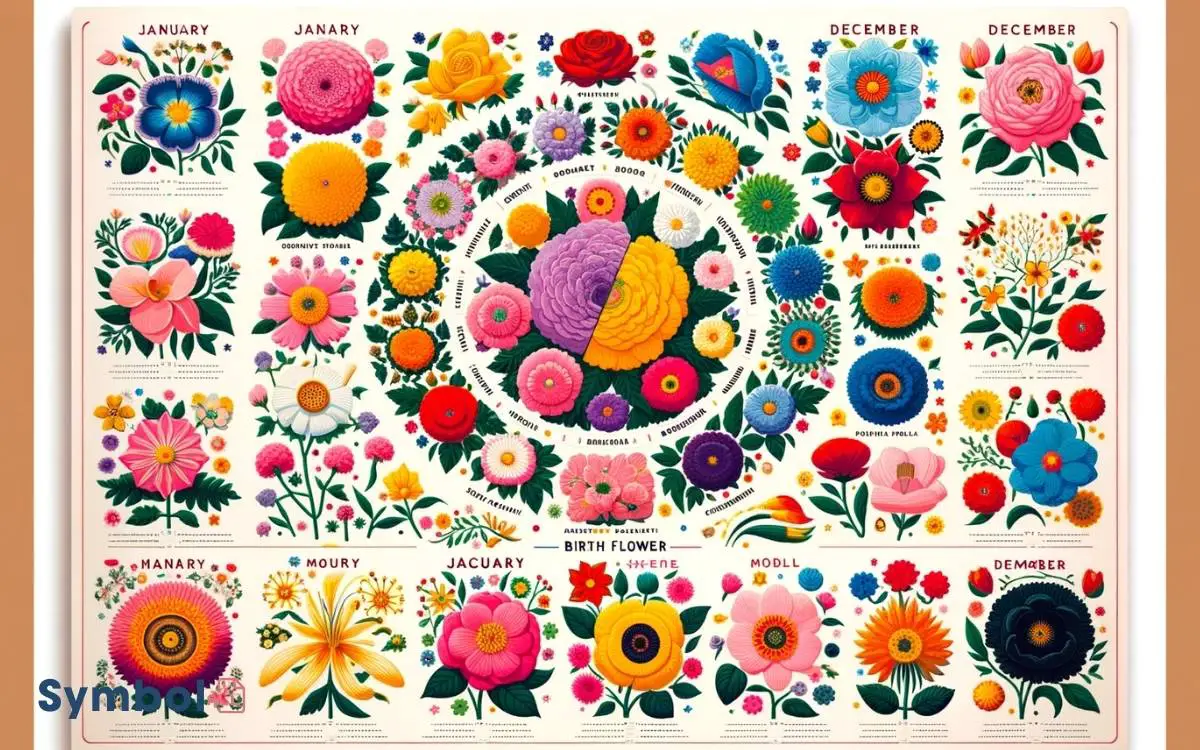Flower Symbol for Each Month: Explains!
Every month, nature gifts a special flower, each with a distinct meaning and scientific significance. January’s snowdrops, known as Galanthus, showcase resilience, thriving in frost with a natural antifreeze protein.
February’s violets symbolize love and fidelity, demanding well-draining soil and partial shade. March brings daffodils, emblems of rebirth, belonging to the Narcissus genus. April’s daisies, symbolizing purity, reveal a complex composite structure.
From the purity of May’s Lily of the Valley to October’s marigolds, symbolizing warmth and optimism with healing properties, each bloom tells a unique story. Discover how these flowers reflect life’s cycle and embody nature’s wisdom.

Key Takeaways
12 Monthly Birth Flowers and Their Symbolic Meanings
| Month | Flower Symbol | Symbolic Meaning |
|---|---|---|
| January | Carnation | Affection, Deep Love |
| February | Violet | Modesty, Faithfulness |
| March | Daffodil | New Beginnings, Prosperity |
| April | Daisy | Innocence, Purity |
| May | Lily of the Valley | Humility, Sweetness |
| June | Rose | Love, Honor |
| July | Larkspur | Levity, Lightness |
| August | Gladiolus | Strength of Character |
| September | Aster | Wisdom, Valor |
| October | Marigold | Creativity, Passion |
| November | Chrysanthemum | Loyalty, Honesty |
| December | Poinsettia | Good Cheer, Success |
January: Snowdrops
Snowdrops, emerging as January’s emblematic flowers, are notable for their resilience and ability to bloom even through the frosty soil. You’ll find these perennials thrive in cold, winter climates, symbolizing hope and purity.
Galanthus, their scientific name, derives from Greek, meaning ‘milk flower,’ reflecting their distinctive, delicate white petals.
These hardy plants possess a natural antifreeze protein, preventing cell damage at freezing temperatures. This adaptation allows snowdrops to be among the first flowers to signal winter’s end.
They’re not just a symbol of resilience; they’re an example of it, pushing through the snow to herald the coming spring. Understanding their biology and symbolism enriches the appreciation of these modest yet mighty flowers, making them a perfect emblem for January.
February: Violets
As you explore the violets of February, you’ll uncover their historical significance, tracing back to ancient civilizations where they held deep symbolic meanings.
These flowers aren’t just a treat for the eyes; their symbolism spans from love and fidelity to humility and spiritual wisdom.
You’ll also learn practical care tips to make sure these delicate blooms thrive in your garden, enhancing their beauty and longevity.
Violets Historical Significance
Throughout history, violets have frequently symbolized faithfulness, humility, and chastity, deeply influencing various cultures around the world since ancient times. These delicate flowers carry a rich history that’s as colorful as their petals.
Let’s break down their significance across different times and cultures:
| Culture | Period | Significance |
|---|---|---|
| Ancient Greece | 500 BC | Used in festivals to symbolize Athens |
| Roman Empire | 27 BC-AD 476 | Associated with funerals, remembering the dead |
| Medieval Europe | 5th-15th Century | Emblem of the Virgin Mary, signifying modesty |
Violets have been more than just flowers; they’ve been powerful symbols throughout human history.
Their enduring presence across millennia speaks volumes about their importance in human culture, reminding us of our shared past and the timeless values we continue to hold dear.
Symbolic Meanings Explored
Building on the historical significance of violets, let’s explore their symbolic meanings in the context of February. Violets, with their vibrant hues and delicate petals, represent loyalty, steadfastness, and humility.
In the language of flowers, a tradition dating back to the Victorian era, giving someone a violet conveys the message ‘I’ll always be true.’
Scientifically, these flowers exhibit the phenomenon of thermogenesis, where they generate their own heat, possibly symbolizing the warmth and fidelity in human relationships.
Additionally, the violet’s modest appearance, often found peeking through early spring snow, symbolizes resilience and the ability to thrive in adversity.
Their association with February speaks to enduring love and the anticipation of spring’s renewal amidst the cold, challenging winter months.
Care Tips for Violets
To guarantee your violets thrive, it’s crucial to provide them with well-draining soil and partial shade, reflecting their natural woodland habitats. These conditions mimic the moisture-retentive yet aerated environment necessary for their root systems.
Make sure the soil’s pH ranges between 6.0 and 7.5, slightly acidic to neutral, enhancing nutrient uptake. Violets flourish under indirect sunlight; direct exposure can scorch their delicate leaves.
Watering requires a delicate balance; keep the soil consistently moist but not waterlogged to prevent root rot. Use a diluted, balanced liquid fertilizer bi-monthly during their active growth period in spring and summer.
Furthermore, maintain high humidity levels by placing the pot on a water-filled pebble tray, avoiding direct contact between the water and the pot’s base to foster a conducive microclimate for growth.
March: Daffodils
As you move into March, daffodils emerge as a symbol of renewal and fresh starts, embodying the essence of spring. Understanding the daffodil’s symbolism and its role as the March birth flower reveals insights into cultural and historical importance.
To guarantee these vibrant blooms thrive, it’s crucial to grasp the specific care tips, from ideal soil conditions to sunlight exposure requirements.
Daffodil Symbolism Explained
Daffodils, blooming in March, symbolize rebirth and new beginnings, heralding the arrival of spring with their vibrant yellow hues. These flowers belong to the genus Narcissus, a name that traces back to Greek mythology, embodying the themes of vanity and self-reflection.
Scientifically, daffodils have a unique structure; their central corona surrounded by petals represents resilience and an ability to thrive in challenging conditions.
This resilience translates metaphorically to human experiences, suggesting that individuals possess the strength to overcome adversity.
Culturally, presenting daffodils in a bouquet symbolizes unrequited love, while a single daffodil warns of misfortune.
However, in various traditions, these flowers are considered auspicious, symbolizing prosperity, luck, and protection against harm, encompassing a complex spectrum of meanings beyond their initial appearance.
March Birth Flower Traits
March’s birth flower, the daffodil, embodies traits of resilience and renewal, reflecting the strength and freshness that mark the onset of spring.
As you explore the scientific intricacies of this vibrant bloom, you’ll discover fascinating attributes:
- Botanical Adaptability: Daffodils thrive in a range of climates, from USDA hardiness zones 3 through 9, showcasing their resilience.
- Photosynthetic Efficiency: Their broad, green leaves efficiently capture sunlight, converting it into energy for growth and bloom.
- Allelopathic Qualities: Daffodils release substances that inhibit the growth of competing plants, ensuring their dominance in their habitat.
- Genetic Diversity: With over 50 species and thousands of hybrids, daffodils exhibit a remarkable genetic variety, contributing to their adaptability and wide range of colors and forms.
Understanding these traits enhances your appreciation of the daffodil’s symbolic representation of new beginnings and resilience.
Daffodil Care Tips
To ensure your daffodils thrive, it’s vital to plant them in well-drained soil, positioned to receive abundant sunlight.
Daffodils require a pH range of 6 to 7 for best growth, so testing your soil’s acidity and adjusting it accordingly is important.
After planting, water them thoroughly to settle the soil around the bulbs, but don’t overwater, as this can lead to bulb rot.
Throughout the growing season, daffodils benefit from a balanced, slow-release fertilizer applied at planting and again as they start to flower.
Deadhead spent flowers to redirect energy to the bulb for next year’s growth, but leave the foliage until it naturally withers. This allows the plant to photosynthesize and store energy for the next blooming season.
April: Daisies
April’s emblematic flower, the daisy, represents purity and innocence, bearing a complex structure that fascinates botanists and gardeners alike. This seemingly simple flower harbors a deep botanical significance and offers a rich palette of symbolism.
Here’s what you should know about daisies:
- Composite Structure: Daisies are composite flowers, meaning what appears to be a single blossom is actually a cluster of smaller flowers.
- Varieties: There are thousands of species, each with unique attributes, from the classic white-petaled with a yellow center to vibrant hues.
- Medicinal Uses: Historically, daisies have been used in traditional medicine for their anti-inflammatory and astringent properties.
- Growth: They thrive in both wild and cultivated settings, showing resilience and adaptability.
Understanding these aspects will deepen your appreciation for April’s quintessential bloom.
May: Lily of the Valley
In May, you turn your attention to the Lily of the Valley, a plant steeped in symbolic meanings and historical significance. Its delicate white blooms aren’t just a herald of spring; they carry deep meanings of humility and the return of happiness, recognized across various cultures.
The flower’s usage in religious and royal ceremonies throughout history underscores its esteemed position in human traditions.
Symbolic Meanings
May’s flower, the Lily of the Valley, symbolizes purity, humility, and the return of happiness, offering a rich tapestry of significance deeply rooted in both cultural traditions and botanical characteristics.
- Purity: The flower’s white, bell-shaped blossoms are often associated with innocence and cleanliness, reflecting a pristine and untouched aspect of nature.
- Humility: Its low-growing nature and delicate appearance symbolize modesty, suggesting that true strength lies in gentleness and simplicity.
- Return of Happiness: Blooming in May, it heralds the end of winter’s dormancy, signifying hope and the renewal of life.
- Renewal: In a botanical sense, the plant’s perennial cycle represents resilience and the ability to thrive anew with each passing season.
Understanding these symbols can deepen your appreciation for the Lily of the Valley and its place in the cycle of life.
Historical Significance
The Lily of the Valley, with its rich historical significance, has been revered across cultures and epochs for its symbolic meanings and uses.
| Culture | Epoch | Significance |
|---|---|---|
| European | Medieval | Sign of Christ’s second coming |
| Asian | Ancient | Used in traditional medicine for heart ailments |
| French | Renaissance | Royal favor, gifted on May 1st as a ‘porte-bonheur’ (bringer of happiness) |
| Global | Contemporary | Birth flower for May, symbolizing return of happiness |
This flower’s allure isn’t just in its delicate appearance but in its versatility and historical depth. It’s a demonstration of how flora can transcend mere aesthetics, embodying rich narratives and practices that span across centuries.
June: Roses
June’s birth flower, the rose, represents passion, beauty, and love, embodying over three hundred species and thousands of cultivars worldwide.
This diverse plant family offers a vast array of colors, each with its symbolic significance:
- Red roses symbolize deep love and respect.
- White roses stand for purity and innocence.
- Yellow roses convey friendship and joy.
- Pink roses express gratitude and admiration.
Equipped with a complex reproductive structure, roses have been a subject of study for botanists aiming to understand their propagation and hybridization techniques.
Their enchanting fragrance isn’t merely for human enjoyment; it plays a critical role in attracting pollinators, ensuring the survival and continuation of their species.
Delving into the world of roses reveals a fascinating blend of beauty, science, and symbolism.
July: Larkspurs
Shifting focus to July, you’ll find that larkspurs, with their enchanting spikes of vibrant blooms, symbolize an open heart and ardent attachment, offering a rich tapestry of color and meaning to explore.
These alluring flowers belong to the Delphinium genus, a term derived from the Greek word ‘delphis’, meaning dolphin, attributed to the shape of their nectary.
Larkspurs exhibit a fascinating range of colors, from deep blues and purples to soft pinks and whites. Each hue carries its own significance; for instance, pink larkspurs convey fickleness, while white ones symbolize happiness.
Remarkably, larkspurs possess certain alkaloids that are toxic to both humans and animals if ingested, a reminder of their beauty and potential danger. This duality adds a layer of complexity to their symbolism, emphasizing caution alongside their aesthetic appeal.
August: Gladiolus
In August, gladioli emerge as the month’s emblematic flowers, renowned for their striking sword-shaped leaves and vibrant, towering spikes of flowers that symbolize strength of character, integrity, and persistence.
These blooms aren’t just a feast for the eyes; they’re steeped in meaning and science.
- Origin: Native to South Africa, gladioli have adapted to a variety of environments.
- Biology: They belong to the Iris family (Iridaceae), showcasing their diversity in form and color.
- Cultivation: Thriving in well-drained soil and full sun, they’re a gardener’s delight for late summer vibrancy.
- Symbolism: Beyond physical strength, they’re often given to convey moral integrity and the power of attraction.
Understanding gladioli’s depth enriches your appreciation for these august blooms, blending beauty with profound symbolism.
September: Asters
As September arrives, asters take the stage as this month’s signature blooms, heralding the shift from summer to fall with their daisy-like flowers and rich symbolism.
These flowers aren’t just eye-catching; they’re packed with meanings and stories. Asters are symbols of love, wisdom, and valor, embodying the warmth and depth of September’s embrace.
| Color Varieties | Symbolic Meanings |
|---|---|
| Purple | Wisdom, Royalty |
| Pink | Sensitivity, Love |
| White | Purity, Innocence |
Native to Eurasia, the name “aster” derives from the Greek word for “star,” aptly describing the flower’s radiance. Asters thrive in cool, moist climates, blooming prolifically as many other flowers begin to fade, offering a vibrant spectacle and a reminder of endurance and the cycle of life.
October: Marigolds
With October’s arrival, marigolds claim their rightful place as the month’s emblematic flower, known for their vibrant colors and significant cultural and medicinal properties. Marigolds, or Tagetes, aren’t just eye-catching; they’re a powerhouse of benefits and symbolism.
Here’s why they’re so special:
- Cultural Significance: In many cultures, marigolds symbolize celebrations of life and remembrance, playing a central role in Day of the Dead festivities in Mexico.
- Healing Properties: They contain antifungal, antibacterial, and anti-inflammatory compounds, making them a staple in traditional medicine.
- Gardening Benefits: Marigolds repel pests and can improve soil health, making them a gardener’s ally.
- Symbolism of Color: Their bright orange and yellow hues symbolize warmth, optimism, and the beauty of change, fitting themes as autumn deepens.
Understanding marigolds enriches your appreciation for October’s unique charm.
Conclusion
As you journey through the year, it’s fascinating how each month’s flower coincidentally reflects the season’s essence. From the resilient snowdrops braving January’s frost to the vibrant marigolds embracing October’s glow, nature’s calendar is intricately designed.
These flowers don’t just mark time; they embody the shifting energies and moods of their respective months. Understanding their characteristics offers a deeper appreciation of nature’s rhythms and the subtle ways it communicates the passage of time and the cycle of life.






